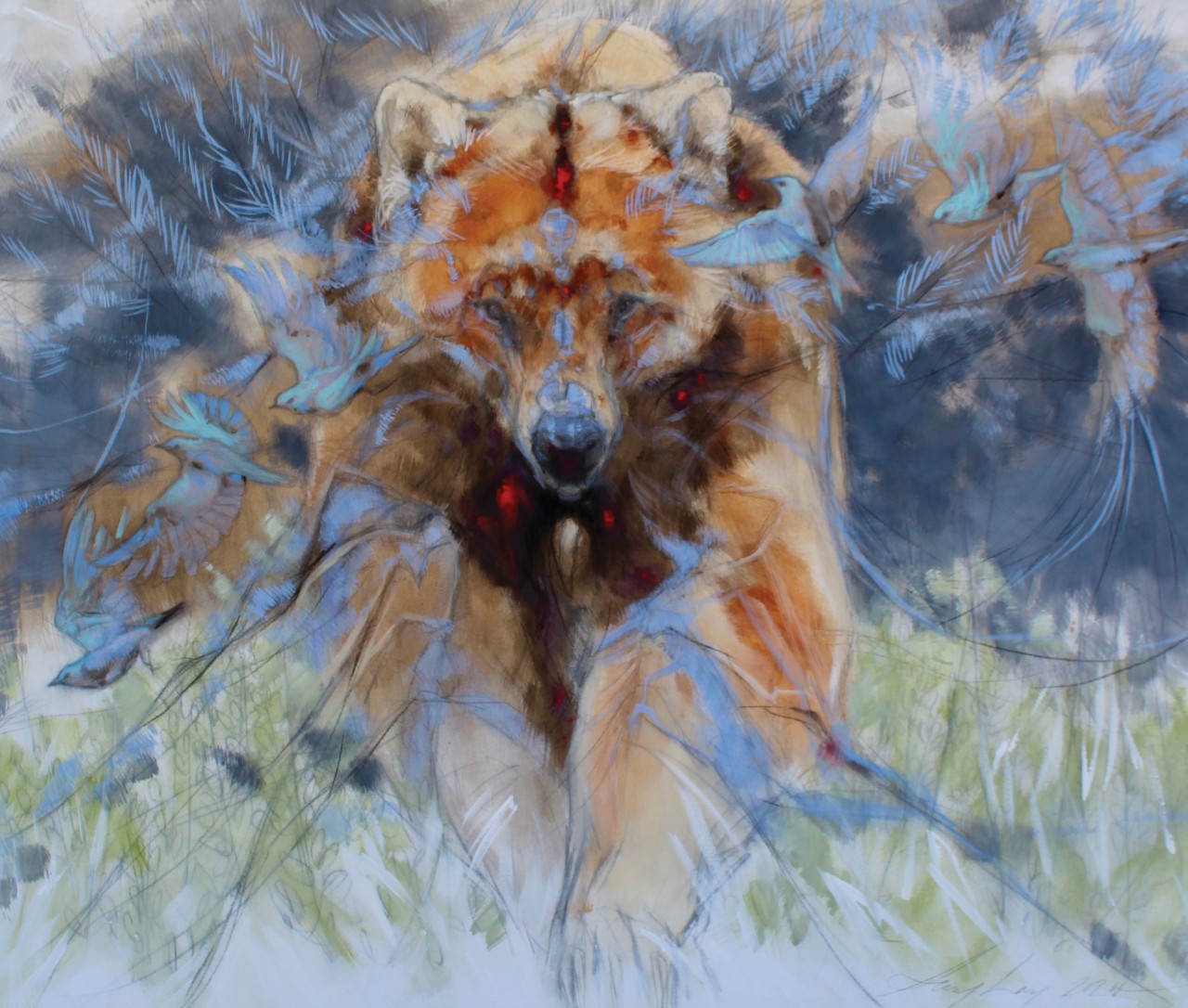
27 May Artist of the West: A Sense of Place
Amy Lay is a full-time artist. Her work appears in galleries across the country, from Manchester, Vermont to Whitefish, Montana. But she’s also a full-time homesteader — the fourth generation to run her family’s ranch in Oregon. “This property and this lifestyle, they’re responsibilities that my cousins and I were born into,” she says. “And I did move away for a bit.” For several years, Lay lived and worked in Jackson, Wyoming, building her career in the town’s vibrant arts community. “But then I came back. I just realized that I love the way I was raised,” she admits. “I love this place.”
To Lay, the American West is home. Her artwork embodies her deeply rooted relationship with the land and its quieter inhabitants. She captures horses mid-stride, owls in flight, bison in stillness — all the animals that call this place home, too.

With Bluebirds At My Back | PENCIL & OIL ON CANVAS | 60 X 72 INCHES
With pencil and oil, she renders wildlife as she knows them, not just as she sees them. “I try not to work from photographs,” Lay says, opting instead to draw from memory and a practiced understanding of form. Her style reflects the same fluency: painterly and expressive, with visible pencil lines that lend the work a raw, gestural energy.
“Amy Lay’s paintings exude a whimsical energy and serene elegance, a testament to her ability to create without relying on a point of reference,” says Sarah Brewster, director of Mountain Trails Gallery in Bozeman, Montana, which represents Lay.
Lay is largely self-taught, though she started her lessons early. “My mom remembers me saying, at 5 years old, ‘I’m going to be an artist,’” she recalls. Her parents were supportive, as artists themselves: her dad is a musician, her mom is a writer. “They just took me at face value: ‘Yeah, you’re going to be an artist.’”
Even then, Lay didn’t harbor illusions about the path ahead. “I knew I’d have to work for it, do something else for work before I made it.”
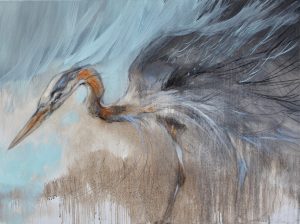
Rhythm Bird | PENCIL & OIL ON CANVAS | 18 X 24 INCHES
Animals came naturally as her subject. “I’m a horse enthusiast,” says Lay. “All my friends growing up had horses.” She remembers riding to their houses on horseback, then heading the 18 miles into town. “We’d go to the grocery store, tie up our horses out back, buy bags of candy, and take off riding together.”
During the warmer months, she’d explore the woods on horseback, searching for wildlife. But in the cold Oregon winters, Lay had to find another way to pass the time. “Everyone in my family had a hobby, some way of keeping busy in the winter,” she says. “When I couldn’t be out riding and exploring, I settled for drawing horses — or the animals I’d seen while riding.”
Lay stayed true to her childhood dream. After graduation, she enrolled in art school and worked with the U.S. Forest Service to support herself. “Then, when I finished art school, I went back to get my teaching degree,” she says.
Lay began teaching history and social studies at the local school, a job that allowed her to stay close to her young children during the day. In the evenings, she coached volleyball. She made time for her art, even with a full-time job, a growing family, and packed days. “I’d finish a workday, coach practice, then go home and take care of my family,” she remembers. She painted late into the night, often staying at her easel until 2 a.m. “I guess I had a lot of energy back then, but I was determined. I was crazy determined.”
She spent summers and long weekends traveling to art festivals around the West. “My family had to stick with me, and my kids were absolute little warriors,” says Lay. “They’d travel with me to different artist events. And it was a good education, I think, to have them periodically leave our small community to see the world with me.”
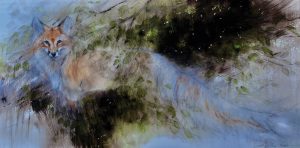
The Night Fox | PENCIL & OIL ON CANVAS | 18 X 36 INCHES
The work and sacrifice paid off. Around 2000, when Lay’s third child was born, her work was accepted into a gallery for the first time. “From that point on, the harder I worked, the better I would do,” she says. “And eventually, it took off.” Lay resigned from teaching and devoted herself, finally, fully, to her art.
Realism is the basis of the American Western art canon. It became the dominant style for many reasons, chief among them a desire to document the expansive wilderness, abundant wildlife, and diverse people who lived beyond the Mississippi River. Artists like George Catlin [1796–1872], Albert Bierstadt [1830–1902], and Frederic Remington [1861–1909] became known for their detailed portrayals of the West during a time when much of the region remained unfamiliar to Eastern audiences. Even as Impressionism gained traction in Europe, many American artists held fast to Realism as a way to record — and sometimes romanticize — the frontier experience.
But Realism is also shaped by perspective. These early artists, working almost exclusively from a male settler point of view, helped shape a legacy in which the West was often cast in terms of conquest and survival. Horses were rendered as instruments of labor or war, bison as brute force, and Indigenous people as either noble or adversarial. Their images were rooted in observation — but also in mythmaking.
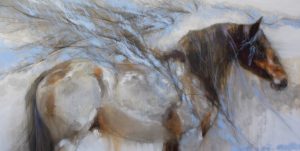
Come Fly With Me | PENCIL & OIL ON CANVAS | 36 X 72 INCHES
Today, many contemporary Western artists continue to work in the realist tradition, capturing the region’s landscapes and inhabitants with careful precision. But Lay takes a different approach. Her work moves away from strict documentation and toward sensation, not just what the scene looks like, but what it feels like. This is what it’s like to glimpse a charging bear. This is what it’s like to encounter a herd of horses on a bright summer morning. “I leave impressions of an animal, of wind, of movement,” says Lay. “But I try to leave the understanding of the scene up to the viewer.”
Her style grew out of years of working in watercolor. “I didn’t want the oil fumes around my kids. Plus, oils are expensive,” she says. When gallerists later encouraged her to begin painting in oil, Lay felt pressure to adapt her work to more traditional expectations. “But I just decided, I’ll approach each work exactly as I would a watercolor — but with oil.”
She layers oil washes with graphite and pencil, allowing the white of the canvas to shine through in places as it would in a watercolor. Lay’s paintings often retain visible pencil lines — a kind of signature. “I want to show the original intent of the drawing and my original intent as the artist,” she says. “I think when you cover up that pencil line, you lose the trueness of the work.”
Her brushwork is confident and expressive, almost sketch-like, lending her subjects a sense of immediacy and motion. Viewing her work feels like flipping through a field journal — raw, intimate, alive. And in many ways, these fleeting impressions feel truer than any literal depiction. Lay offers an instinctive, emotional vision of the West through her painterly style, one shaped not by conquest or spectacle, but by memory, intimacy, and deep reverence.
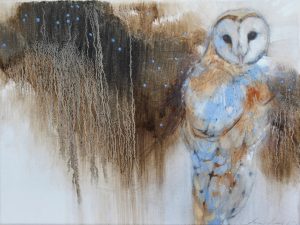
Night Mask | PENCIL & OIL ON CANVAS | 12 X 16 INCHES
This summer, Lay will showcase new work at several solo shows throughout Montana and Wyoming. She’s been experimenting with movement and form, pairing different animals together in a scene. “I’m interested in the conversation between subjects on a single canvas,” Lay explains. Each piece becomes a kind of dialogue between animals, between gestures, between Lay and the land that raised her.
Halina Loft is a writer and editor based in Bozeman, Montana. Before moving west, she worked as an arts editor for Sotheby’s in New York City.




No Comments